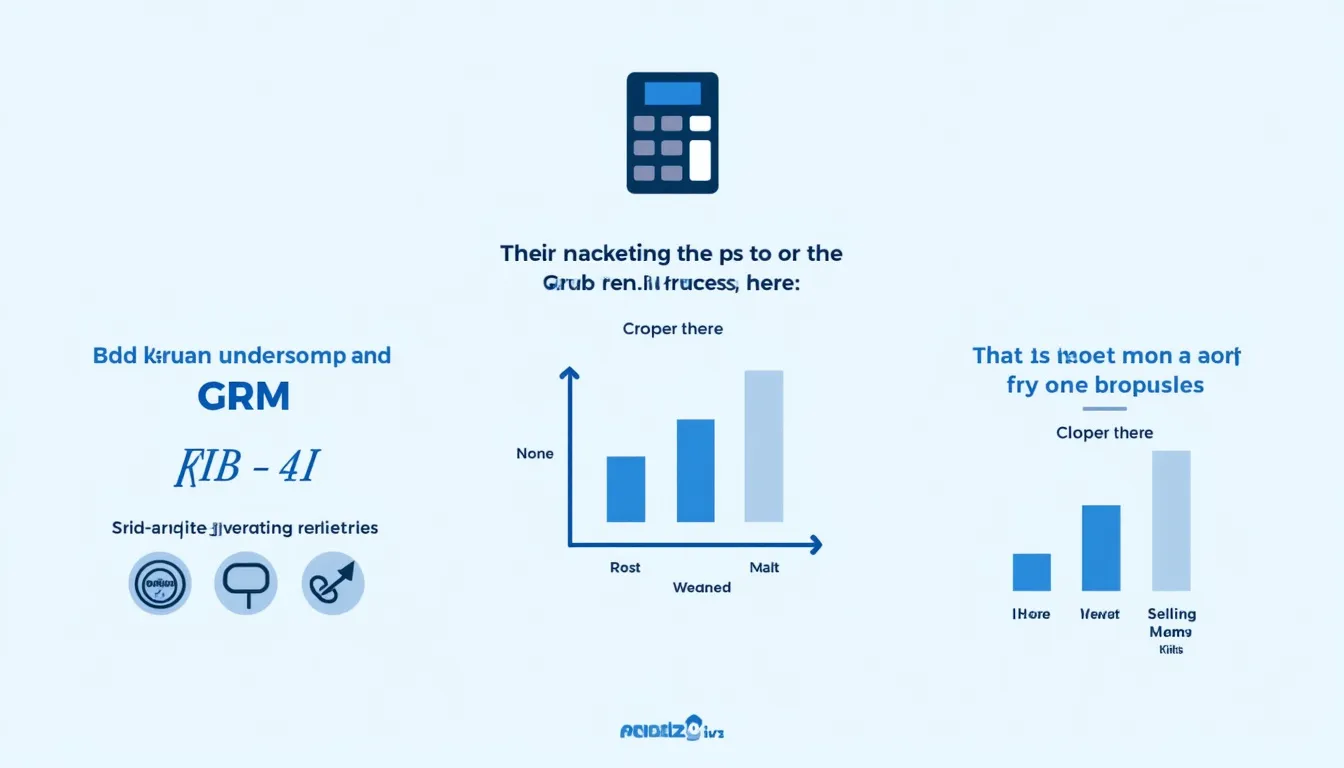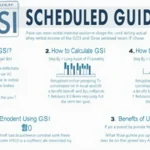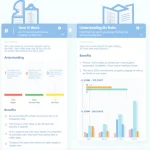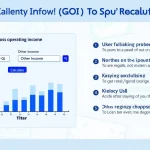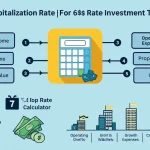Gross Rent Multiplier Calculator
Is this tool helpful?
How to Use the Gross Rent Multiplier Calculator Effectively
Our Gross Rent Multiplier (GRM) Calculator is designed to help real estate investors, property managers, and analysts quickly assess the potential value of income-producing properties. To use this tool effectively, follow these simple steps:
- Enter the current market value of the property in dollars.
- Input the annual rental income from occupied units in dollars.
- Provide the annual income lost due to vacant units in dollars.
- Click the “Calculate GRM” button to get your result.
The calculator will then display the Gross Rent Multiplier, a crucial metric for evaluating real estate investments.
Understanding the Gross Rent Multiplier: Definition, Purpose, and Benefits
The Gross Rent Multiplier (GRM) is a fundamental real estate investment analysis tool that helps investors quickly estimate a property’s value based on its gross rental income. It’s calculated using the following formula:
$$ GRM = \frac{Market Value}{Gross Scheduled Income} $$Where:
- Market Value is the current estimated value of the property
- Gross Scheduled Income is the total annual rental income, including both collected rent and potential rent from vacant units
The purpose of the GRM is to provide a quick, initial assessment of a property’s investment potential. It allows investors to compare different properties and make preliminary decisions about which opportunities warrant further investigation.
Key Benefits of Using the Gross Rent Multiplier
- Rapid evaluation of investment properties
- Easy comparison between multiple properties
- Identification of potentially undervalued or overvalued properties
- Simplified communication of property value among real estate professionals
- Quick estimation of property values based on rental income
How the Gross Rent Multiplier Calculator Addresses User Needs
Our GRM Calculator addresses several key needs for real estate investors and professionals:
1. Time-Saving Calculations
Instead of manually crunching numbers, users can input three simple values and receive an instant GRM calculation. This saves valuable time, especially when evaluating multiple properties.
2. Accuracy and Consistency
By using a standardized calculator, users eliminate the risk of human error in calculations, ensuring consistent results across all property evaluations.
3. Consideration of Vacancy
Unlike some basic GRM calculations that only consider actual rental income, our calculator factors in lost income from vacant units. This provides a more accurate representation of the property’s potential.
4. User-Friendly Interface
The clean, intuitive design of our calculator makes it accessible to both seasoned real estate professionals and novice investors.
Practical Applications and Example Calculations
Let’s explore some practical applications of the Gross Rent Multiplier Calculator with example calculations:
Example 1: Comparing Two Residential Properties
Property A:
- Market Value: $500,000
- Rental Income: $48,000
- Lost Income from Vacant Units: $2,000
Using our calculator:
GRM = $500,000 / ($48,000 + $2,000) = 10
Property B:
- Market Value: $600,000
- Rental Income: $54,000
- Lost Income from Vacant Units: $3,000
Using our calculator:
GRM = $600,000 / ($54,000 + $3,000) = 10.53
In this comparison, Property A has a lower GRM, potentially indicating a better value for the investor. However, other factors should be considered before making a final decision.
Example 2: Estimating Property Value
Suppose you know the GRM for similar properties in an area is around 8, and you’re considering a property with the following details:
- Rental Income: $60,000
- Lost Income from Vacant Units: $4,000
You can estimate the property’s market value:
Estimated Market Value = GRM × Gross Scheduled Income
Estimated Market Value = 8 × ($60,000 + $4,000) = $512,000
This estimation can help you determine if the asking price is reasonable based on local market conditions.
Example 3: Analyzing a Commercial Property
For a small office building:
- Market Value: $2,000,000
- Rental Income: $180,000
- Lost Income from Vacant Units: $20,000
Using our calculator:
GRM = $2,000,000 / ($180,000 + $20,000) = 10
This GRM can be compared to other commercial properties in the area to assess its relative value.
Benefits of Using the Gross Rent Multiplier Calculator
1. Efficient Decision Making
By quickly calculating the GRM for multiple properties, investors can efficiently shortlist potential investments, focusing their time and resources on the most promising opportunities.
2. Risk Assessment
A property with a significantly higher GRM than comparable properties in the area may indicate overvaluation, helping investors avoid potentially risky investments.
3. Negotiation Tool
Armed with GRM calculations, buyers can negotiate more effectively, using the metric to justify offers below asking price if the GRM is higher than market norms.
4. Portfolio Optimization
For investors with multiple properties, regularly calculating and comparing GRMs can help identify underperforming assets that may need attention or consideration for sale.
5. Market Trend Analysis
By tracking GRMs over time, investors can identify trends in specific markets, potentially spotting opportunities before they become widely recognized.
Limitations and Considerations
While the Gross Rent Multiplier is a valuable tool, it’s important to understand its limitations:
- GRM doesn’t account for operating expenses, which can vary significantly between properties.
- It doesn’t consider potential for appreciation or depreciation.
- Financing costs are not factored into the GRM calculation.
- Local market conditions and property-specific factors may not be reflected in the GRM.
Therefore, while the GRM Calculator is an excellent starting point for property evaluation, it should be used in conjunction with other financial metrics and thorough due diligence.
Frequently Asked Questions (FAQ)
Q1: What is a good Gross Rent Multiplier?
A: There’s no universally “good” GRM as it varies by location, property type, and market conditions. Generally, a lower GRM suggests a better value, but it’s crucial to compare GRMs of similar properties in the same area for meaningful insights.
Q2: How often should I calculate the GRM for my properties?
A: It’s advisable to recalculate GRM annually or whenever there are significant changes in the property’s value or rental income. Regular calculations help track performance and market trends.
Q3: Can GRM be used for all types of real estate investments?
A: While GRM can be calculated for any income-producing property, it’s most commonly used for residential and small commercial properties. For larger commercial investments, more comprehensive metrics like Cap Rate are often preferred.
Q4: How does GRM differ from Capitalization Rate?
A: GRM uses gross rental income, while Capitalization Rate (Cap Rate) uses net operating income. Cap Rate provides a more detailed view of a property’s profitability as it accounts for operating expenses.
Q5: Should I always choose the property with the lowest GRM?
A: Not necessarily. While a lower GRM often indicates better value, it’s important to consider other factors such as property condition, location, potential for appreciation, and your investment goals.
Q6: How accurate is the GRM Calculator?
A: Our GRM Calculator provides accurate results based on the input provided. However, it’s important to note that we can’t guarantee that the webtool or results from our webtool are always correct, complete, or reliable. Our content and tools might have mistakes, biases, or inconsistencies.
Conclusion: Harnessing the Power of the Gross Rent Multiplier Calculator
The Gross Rent Multiplier Calculator is an invaluable tool for real estate investors, offering a quick and efficient way to evaluate income-producing properties. By providing instant GRM calculations, it empowers users to:
- Rapidly assess potential investments
- Compare properties on an equal footing
- Identify potentially undervalued opportunities
- Make more informed investment decisions
- Optimize existing real estate portfolios
While the GRM should not be the sole factor in real estate investment decisions, it serves as an excellent starting point for further analysis. By incorporating the Gross Rent Multiplier Calculator into your investment strategy, you can streamline your property evaluation process and gain valuable insights that contribute to more successful real estate investments.
Take advantage of this powerful tool today and elevate your real estate investment analysis to new heights. Remember to use the GRM Calculator in conjunction with other financial metrics and thorough market research for comprehensive property evaluations.
Ready to calculate your next property’s GRM? Use our Gross Rent Multiplier Calculator now and take the first step towards smarter real estate investments!
Important Disclaimer
The calculations, results, and content provided by our tools are not guaranteed to be accurate, complete, or reliable. Users are responsible for verifying and interpreting the results. Our content and tools may contain errors, biases, or inconsistencies. We reserve the right to save inputs and outputs from our tools for the purposes of error debugging, bias identification, and performance improvement. External companies providing AI models used in our tools may also save and process data in accordance with their own policies. By using our tools, you consent to this data collection and processing. We reserve the right to limit the usage of our tools based on current usability factors. By using our tools, you acknowledge that you have read, understood, and agreed to this disclaimer. You accept the inherent risks and limitations associated with the use of our tools and services.
